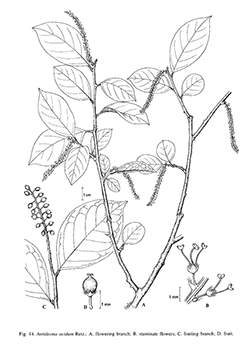e-Flora of Thailand
Volume 8 > Part 1 > Year 2005 > Page 59 > Euphorbiaceae > Antidesma
1. Antidesma acidum Retz.wfo-0000234922
Obs. Bot. 5: 30. 1788, ‘acida’; Müll.Arg. in DC., Prodr. 15(2): 249. 1866; Airy Shaw, Kew Bull. 26: 352. 1971; Grierson & Long, Fl. Bhutan 786, fig. 48 h-j. 1987. Fig. 14.
Accepted Name : This is currently accepted.
Description : Shrub to tree, up to 10 m high, dbh up to 10 cm; usually branched from the base; young twigs pilose to pubescent, brown. Stipules usually persistent, linear, 3–7 by 1–2 mm, slightly pilose to (especially apically) densely pubescent. Leaves: petiole 2–7 by 1–2 mm, pilose to densely pubescent; blade obovate to elliptic-oblong, (2–)5–10(–18) by (1–)2.5–4–8)cm, (1.6–)2–2.5(–4.5) times longer than wide, base acute or obtuse, mostly cuneate, apex long to very shortly acuminate to rounded, chartaceous, glabrous or rarely slightly pilose adaxially, pilose to pubescent at least in the axils between midrib and secondary veins, rarely completely glabrous abaxially, midrib flat to impressed adaxially, tertiary veins reticulate, domatia present. Staminate inflorescences 5–14 cm long, axillary, simple or branched twice at the base, axis glabrous to pubescent; bracts orbicular to lanceolate, 0.6–1 by 0.6 mm, glabrous. Staminate flowers 2–2.5 by 1–1.5 mm; pedicel 1–1.5 mm long, very thin; calyx 0.5 by 0.8 mm, globose to cup-shaped; sepals 4, fused for ca ⅔rd of their length, irregularly shaped, glabrous outside, pubescent inside with hairs often exceeding the calyx; disc cushion-shaped, enclosing the bases of the filaments, pubescent; stamens 2, rarely 3, 1.5–2 mm long, 1.5–2 mm long exserted from the calyx; anthers 0.3 by 0.6 mm; pistillode absent. Pistillate inflorescences 2–3 cm long, axillary, simple to branched twice at the base, axis glabrous to pubescent; bracts orbicular to lanceolate, 0.5–0.7 by 0.5 mm, glabrous. Pistillate flowers 2 by 1 mm; pedicel 0.2–1 mm long; calyx 1 by 1 mm, pitcher-shaped; sepals 4 (or 5), fused for ca ⅔rd of their length, apically acute, glabrous outside, pubescent inside with hairs often exceeding the calyx; disc shorter than the sepals, glabrous inside, glabrous to pilose outside; ovary ovoid, glabrous; style usually terminal; stigmas 3 or 4. Infructescences 2–5(–8) cm long; pedicel 1.5–3 mm long; fruits ellipsoid, terete or laterally compressed, basally symmetrical, with a terminal to slightly subterminal style, 4–6 by 3–4 mm, glabrous.
Thailand : NORTHERN: Mae Hong Son, Chiang Mai, Chiang Rai, Nan, Lamphun, Lampang, Phrae, Tak, Phitsanulok, Kamphaeng Phet; NORTH-EASTERN: Phetchabun, Loei, Nakhon Phanom; EASTERN: Buri Ram, Surin, Si Sa Ket, Ubon Ratchathani; SOUTH-WESTERN: Uthai Thani, Kanchanaburi, Ratchaburi; CENTRAL: Saraburi; SOUTH-EASTERN: Chon Buri, Chanthaburi; PENINSULAR: Ranong, Phangnga, Krabi, Satun.
Distribution : India (type) including the Andaman and Nicobar Islands, Nepal, S China, Bangladesh, Burma, Laos, Vietnam, Cambodia, Java. Absent in Malesia except Java, absent in Sri Lanka. Distribution map in Baker et al. (1998: 252, fig. 6D).
Ecology : In dry deciduous, deciduous and evergreen forests, forests edges, open spaces, bamboo thickets; open or half-shady habitats; secondary, often disturbed, much degraded or frequently burnt vegetation; on sandy gravel, sand, silt or red lateritic soil, over limestone, granite and shale-granite; 0–1,600 m alt.
Vernacular : Mao ta khwai (เม่าตาควาย)(Chiang Rai); makmao (มักเม่า)(Lampang); mao (เม่า)(Northern); mao soi (เม่าสร้อย)(Loei); hao-cha (Karen).
Uses: Fruits eaten. Young leaves used in curry and as vegetable (India and Thailand).

